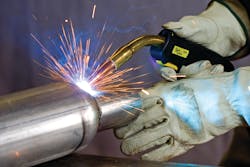Being a Better Welder
Whether you weld every day or only occasionally, you are probably always looking for ways to improve the integrity and cosmetic look of your welds. Numerous welders on the market can help with one or both of those issues, but machines aren’t always the answer. In Gas Metal Arc Welding (GMAW), consistent wire feed is crucial to the strength and appearance of a weld. There are plenty of ways to identify and improve upon GMAW wire feed that will result in quality, visually pleasing welds.
Smooth Wire Feed
Smooth wire feed is important to prevent situations that can cost you time and weld quality. Two such situations are known as burnback and birdnesting, caused by improper wire feed speed. If the wire is fed too slowly at the start of the weld, burnback may occur. As a result, the contact tip will have to be replaced. If the wire continues to feed and the drive roll tension prevents slippage, the wire may tangle into a “bird’s nest” between the drive rolls and the GMAW gun. This takes time to clear the old wire and feed it back through the gun.
Conduit Failure and Its Effect on the Weld
You can learn to recognize conduit failure prior to gun failure. One physical indicator of impending conduit failure is debris build-up. This is first seen as metal shavings or particles at the inlet side of the contact tip. Normal friction and abrasion in the wire feeding process cause fine metallic dust to be carried along inside the conduit until it exits at the end and is deposited at the inlet of the contact tip. A portion of this debris will be carried inside the tip as well, causing a buildup of foreign material which may cause arcing at various points inside the tip. This buildup will impede smooth wire feed and current transfer, cause inconsistent wire feed speeds and possibly wire burnback. Shop air can help clear the conduit of debris, but the construction of the conduit may make it difficult to clean.
Grooving in the conduit can also occur over time. This causes increased friction on the wire, which in turn can cause build-up of debris inside the conduit. It is normal to have some debris from the drive rolls to the tip due to natural flaws in the wires. However, if it becomes excessive, it might be time to replace the conduit altogether.
Other indicators of failure can include, but are not limited to, inconsistent arc length, poor contact tip life, discoloration of liners, or noticeable vibration in the handle of the gun. Each one of these may not seem a major issue, but together they can seriously affect the machine and your ability to produce a quality weld.
Behind the Scenes of Poor Wire Feed
Several other factors can contribute to poor wire feed, one being poor gun layout. If the wire has to travel through too many loops, it can affect the speed at which the wire travels through different parts of the conduit, making wire feed erratic. Draping the gun over tools or fixtures that cause changes in the elevation of the gun also can affect feed speed consistency. Ineffective support at the feeder end of the gun can increase the drag on the wire, which can affect weld quality.
Improper conduit or liner installation is a major contributor to poor wire feed. Be careful when inserting a new conduit into the gun to prevent kinking of the liner material. If the conduit is kinked during assembly, it will remain that way no matter how well you think you have fixed it. This kink can then cause more friction for the wire as it travels through the conduit, resulting in weakening of the weld and increased wear on the conduit. To prevent kinking, lay the gun as straight as possible and slowly insert the conduit into the gun.
Proper conduit length inside the gun also is important. If the conduit is too short, the wire may not line up properly with the contact tip and create more friction, resulting in abnormal wear of the contact tip and increased feed resistance. If the conduit is too long, it would be forced into a wave-type pattern inside the gun, which also would build feed resistance.
Drive roll tension can also impact wire feed. If the tension is set too low, the wire can slip, resulting in shaving or flat spots on the wire that will produce erratic feed speed and inconsistent arc lengths. If the tension is set too high, it can cause the wire to be flattened and misshapen which can then cause tip clearance issues.
It is important to match the size of conduit with the size of wire being used. For example, using an oversized liner can cause bunching or surging of wire at the contact tip that will affect the weld. Additionally, too small or too hard a conduit can create more friction and drag that also can affect the weld.
Other factors related to wire feed include a worn out conduit, misalignment of the gun at the wire feeder, and the presence of burrs from wire and from the ends of the conduit. Each of these can be avoided just by taking proper care during setup and replacement of the consumables.
Remember, it is essential to be able to identify issues with wire feedability and to know how to fix them. You will find that by doing so, it becomes much easier to become a more efficient and skilled welder, saving yourself time, money, and resources.
